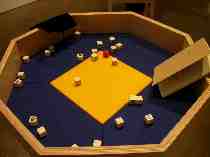
I’m not a fan of fortune telling, but I like the idea that people are always looking for signs and predictions…that we’re trying to divine the subtext of life and our own part in it. (top image is “Your Fate” detail of a dice table)

We saw two omen-ous and sign-ful shows in New York, “Your Fate” by Allan McCollum and Matt Mullican at Christine Burgin and Barbara Kruger‘s new video work at Mary Boone in Chelsea.
And while the shows bore no physical resemblance to each other, they seemed to be focussed on many of the same things — how signs get used in story-telling and the human proclivity to create subtext. Both shows are great in their own way and together they make a good pair, although you have to hurry because signs point to them closing April 24.
Your Fate
“Your Fate,” a collaboration between McCollum and Mullican, is a fortune telling dice game that has Atlantic City-like trappings — three felt-padded tables for throwing, a black velvet bag to hold the dice and a gallery attendant who acts as a kind of interpreter or reader or croupier. (image above is dice table and drawings of the signs represented on the dice)
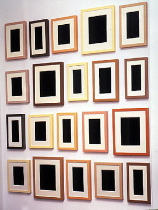
But the dice, which sport symbols from daily life (like the universal male and female bathroom symbols) are so generic and open they can mean everything — and nothing. And that’s the point, I guess. As a predicter of the future, Your Fate is in your hands — it’s not in the signs.
Both artists, McCollum, 60, and Mullican, 53, have long made work that deals with symbols and signifiers. McCollum’s website, which I recommend, is one of the best artist websites I’ve encountered, by the way.

Both artists use multiples in their work and this exhibit, which includes 100 sets of dice in addition to three sets of drawings, is no exception. (image of McCollum’s Plaster Surrogate Paintings, right, and Mullican’s imagery from a banner project, left).
By the way, Mullican had a solo show of his banners in 1987 at Moore College. And both Mullican and McCollum will be in the upcoming Big Nothing at the ICA. “Your Fate” would be a perfect piece for that show, a game signifying everything and nothing.
Because the work feeds on the viewer’s need to know about themselves, the game seems apt for our navel-gazing, self-help-obsessed times. Your Fate is like a kind of viewer-participatory portraiture. Throw the dice and what you see is…you — Narcissus looking down to see her reflection in the dice.
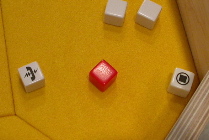
The artists must have had a lot of fun with this. (I know I did. That’s me in the detail shot–I’m the red die bracketed by the big square in the circle die and the telephone die. I AM a big square and I do happen to own a telephone and/or communication device. So that’s me for sure.
In the gallery notes, the artists explain they like the game aspect very much. Mullican says “My work has referred to games for over twenty years but this is the first game that I have helped to invent.”
They also confess they are both interested in psychic phenomena and how that “plays into peoples’ knowledge of the world.”
I just liked the subversion of it all — making a fortune teller that is not a fortune teller, yet giving the viewer the opportunity to process information about themselves and feed their ego. The whole enterprise felt a lot like the way news and information is delivered today — quick, graphic chunks without a lot of significant analysis.
Your real world?
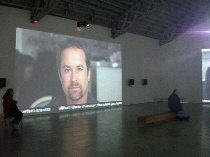
Speaking of news and information, Barbara Kruger’s four-screen video projection takes aim at contemporary media. And, in a piece that’s more entertaining than I remember Kruger’s work being (mostly I think of her as a talk-truth-to-power artist albeit one with a sense of humor) the artist unmasks the unreality in some of those reality shows and questions the validity of news delivered in screen-crawling worms operating under perky, dimpled news readers telling often silly tales.
Kruger has always been about subliminal messaging. A lot of her earlier work was devoted to advertising and false messages about body and self-image. In a way, she’s mining the same territory here, only in moving imagery and with theatrical dialog.
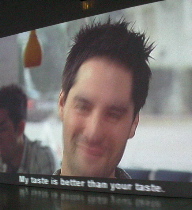
In several short vignettes scripted by the artist and acted by actors, talking heads are projected large in the dark space. A CNN-type “crawl” runs at the bottom, projecting a series of sentences that are the interior monologue of the speaker (who’s usually saying something else). Occasionally the interior monologue is the same for all the participants, like it was for a catty segment involving high school girls and also one involving 20-something guys talking about cars. That was amusing. (three images from the vignette about art. “My taste is better than your taste,” says one pompous art-speaker to himself, smirking)

The scenes take place around tables — in a diner, a school cafeteria, a family dining room — and the discussions range from high falutin’ talk about art and photography in one case to emotional territory about relationships where jealousy and suspicion are spoken themes and hurt and anger are the subtext crawling along the bottom. Interior self image clashes with overt posture every step of the way.
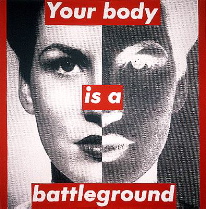
In the family scene, mother, dad, sis and brother hurl barbs or chew in silence. Dad is reading the paper and says, importantly, that “This (meaniing the newspaper) is important. This is the world.” Mom snaps back that “THIS (meaning the family) is the world.”
Whatever. Kruger’s “real world” soap operas don’t so much speak truth to power, but they do whisper that image is fleeting, emotional undercurrents are stronger than you guess and sometimes people are not the best signifiers of their own true selves. (image is Kruger’s “Your body is a battleground”)
Read more about Kruger at PBS’s Art 21 site.
Finally, it occurs to me that whereas Kruger previous stridency was a reflection of the advertising mentality she was railing against, here, parodying the cool media of television, she’s adopted an insinuating, ingratiating and info-taining affect that is “real tv” if not “real world.” It gets the point across.









